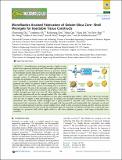| dc.contributor.author | Cha, Chaenyung | |
| dc.contributor.author | Oh, Jonghyun | |
| dc.contributor.author | Kim, Keekyoung | |
| dc.contributor.author | Qiu, Yiling | |
| dc.contributor.author | Joh, Maria | |
| dc.contributor.author | Shin, Su Ryon | |
| dc.contributor.author | Wang, Xin | |
| dc.contributor.author | Camci-Unal, Gulden | |
| dc.contributor.author | Wan, Kai-tak | |
| dc.contributor.author | Liao, Ronglih | |
| dc.contributor.author | Khademhosseini, Ali | |
| dc.date.accessioned | 2015-04-23T15:35:44Z | |
| dc.date.available | 2015-04-23T15:35:44Z | |
| dc.date.issued | 2014-01 | |
| dc.date.submitted | 2013-12 | |
| dc.identifier.issn | 1525-7797 | |
| dc.identifier.issn | 1526-4602 | |
| dc.identifier.uri | http://hdl.handle.net/1721.1/96738 | |
| dc.description.abstract | Microfabrication technology provides a highly versatile platform for engineering hydrogels used in biomedical applications with high-resolution control and injectability. Herein, we present a strategy of microfluidics-assisted fabrication photo-cross-linkable gelatin microgels, coupled with providing protective silica hydrogel layer on the microgel surface to ultimately generate gelatin-silica core–shell microgels for applications as in vitro cell culture platform and injectable tissue constructs. A microfluidic device having flow-focusing channel geometry was utilized to generate droplets containing methacrylated gelatin (GelMA), followed by a photo-cross-linking step to synthesize GelMA microgels. The size of the microgels could easily be controlled by varying the ratio of flow rates of aqueous and oil phases. Then, the GelMA microgels were used as in vitro cell culture platform to grow cardiac side population cells on the microgel surface. The cells readily adhered on the microgel surface and proliferated over time while maintaining high viability (∼90%). The cells on the microgels were also able to migrate to their surrounding area. In addition, the microgels eventually degraded over time. These results demonstrate that cell-seeded GelMA microgels have a great potential as injectable tissue constructs. Furthermore, we demonstrated that coating the cells on GelMA microgels with biocompatible and biodegradable silica hydrogels via sol–gel method provided significant protection against oxidative stress which is often encountered during and after injection into host tissues, and detrimental to the cells. Overall, the microfluidic approach to generate cell-adhesive microgel core, coupled with silica hydrogels as a protective shell, will be highly useful as a cell culture platform to generate a wide range of injectable tissue constructs. | en_US |
| dc.description.sponsorship | United States. Office of Naval Research (Young National Investigator Award) | en_US |
| dc.description.sponsorship | United States. Office of Naval Research (Presidential Early Career Award for Scientists and Engineers) | en_US |
| dc.description.sponsorship | National Science Foundation (U.S.) (CAREER Award (DMR 0847287) | en_US |
| dc.description.sponsorship | National Institutes of Health (U.S.) (HL092836) | en_US |
| dc.description.sponsorship | National Institutes of Health (U.S.) (DE019024) | en_US |
| dc.description.sponsorship | National Institutes of Health (U.S.) (EB012597) | en_US |
| dc.description.sponsorship | National Institutes of Health (U.S.) (AR057837) | en_US |
| dc.description.sponsorship | National Institutes of Health (U.S.) (EB008392) | en_US |
| dc.description.sponsorship | National Institutes of Health (U.S.) (HL099073) | en_US |
| dc.language.iso | en_US | |
| dc.publisher | American Chemical Society (ACS) | en_US |
| dc.relation.isversionof | http://dx.doi.org/10.1021/bm401533y | en_US |
| dc.rights | Article is made available in accordance with the publisher's policy and may be subject to US copyright law. Please refer to the publisher's site for terms of use. | en_US |
| dc.source | American Chemical Society | en_US |
| dc.title | Microfluidics-Assisted Fabrication of Gelatin-Silica Core–Shell Microgels for Injectable Tissue Constructs | en_US |
| dc.type | Article | en_US |
| dc.identifier.citation | Cha, Chaenyung, Jonghyun Oh, Keekyoung Kim, Yiling Qiu, Maria Joh, Su Ryon Shin, Xin Wang, et al. “Microfluidics-Assisted Fabrication of Gelatin-Silica Core–Shell Microgels for Injectable Tissue Constructs.” Biomacromolecules 15, no. 1 (January 13, 2014): 283–290. © 2013 American Chemical Society. | en_US |
| dc.contributor.department | Harvard University--MIT Division of Health Sciences and Technology | en_US |
| dc.contributor.mitauthor | Cha, Chaenyung | en_US |
| dc.contributor.mitauthor | Shin, Su Ryon | en_US |
| dc.contributor.mitauthor | Camci-Unal, Gulden | en_US |
| dc.contributor.mitauthor | Khademhosseini, Ali | en_US |
| dc.relation.journal | Biomacromolecules | en_US |
| dc.eprint.version | Final published version | en_US |
| dc.type.uri | http://purl.org/eprint/type/JournalArticle | en_US |
| eprint.status | http://purl.org/eprint/status/PeerReviewed | en_US |
| dspace.orderedauthors | Cha, Chaenyung; Oh, Jonghyun; Kim, Keekyoung; Qiu, Yiling; Joh, Maria; Shin, Su Ryon; Wang, Xin; Camci-Unal, Gulden; Wan, Kai-tak; Liao, Ronglih; Khademhosseini, Ali | en_US |
| mit.license | PUBLISHER_POLICY | en_US |
| mit.metadata.status | Complete | |
